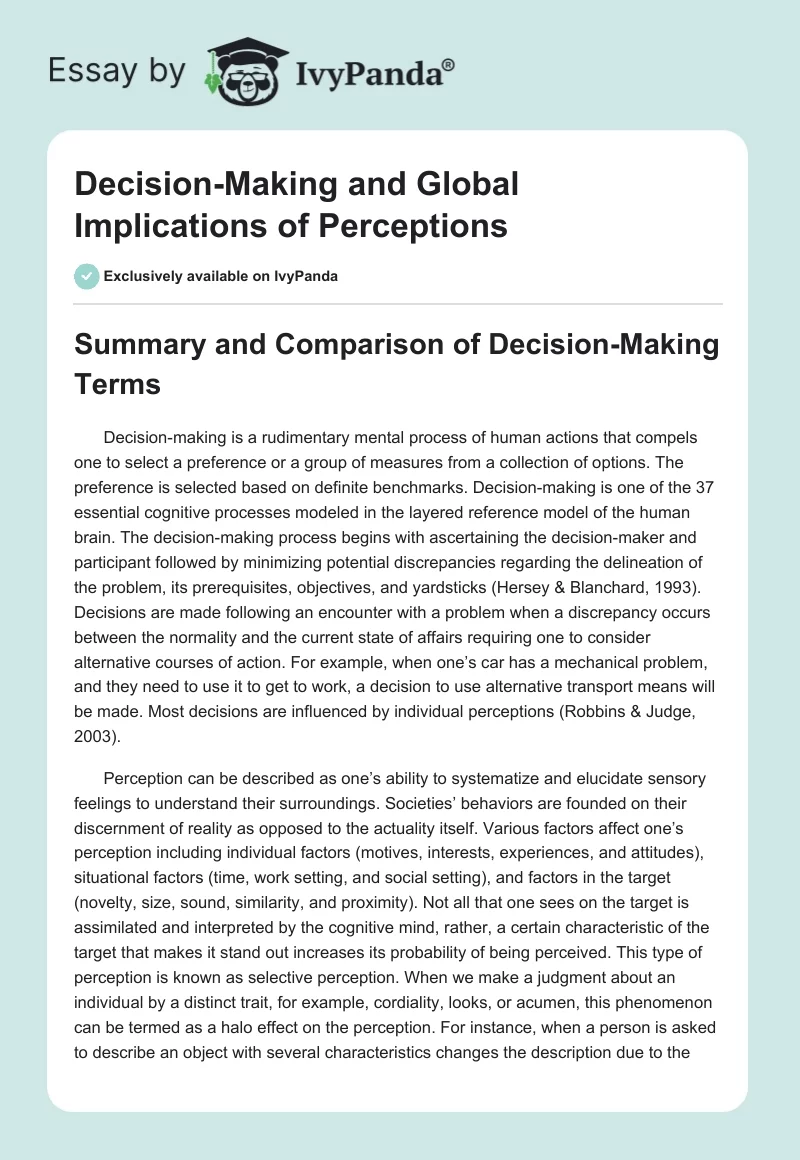Summary and Comparison of Decision-Making Terms
Decision-making is a rudimentary mental process of human actions that compels one to select a preference or a group of measures from a collection of options. The preference is selected based on definite benchmarks. Decision-making is one of the 37 essential cognitive processes modeled in the layered reference model of the human brain. The decision-making process begins with ascertaining the decision-maker and participant followed by minimizing potential discrepancies regarding the delineation of the problem, its prerequisites, objectives, and yardsticks (Hersey & Blanchard, 1993). Decisions are made following an encounter with a problem when a discrepancy occurs between the normality and the current state of affairs requiring one to consider alternative courses of action. For example, when one’s car has a mechanical problem, and they need to use it to get to work, a decision to use alternative transport means will be made. Most decisions are influenced by individual perceptions (Robbins & Judge, 2003).
Perception can be described as one’s ability to systematize and elucidate sensory feelings to understand their surroundings. Societies’ behaviors are founded on their discernment of reality as opposed to the actuality itself. Various factors affect one’s perception including individual factors (motives, interests, experiences, and attitudes), situational factors (time, work setting, and social setting), and factors in the target (novelty, size, sound, similarity, and proximity). Not all that one sees on the target is assimilated and interpreted by the cognitive mind, rather, a certain characteristic of the target that makes it stand out increases its probability of being perceived. This type of perception is known as selective perception. When we make a judgment about an individual by a distinct trait, for example, cordiality, looks, or acumen, this phenomenon can be termed as a halo effect on the perception. For instance, when a person is asked to describe an object with several characteristics changes the description due to the introduction of a single new trait, then a single trait has influenced the person’s impression of the object. Finally, when the appraisal of an individual’s traits is influenced by distinguishing with other people of differing standings on the same features, a contrast effect ensues (Hersey & Blanchard, 1993; Robbins & Judge, 2003).
Global Implications of Perceptions and Decision-Making
Precision and decision-making have several global implications ranging from business to cultural and ethical. There are cultural discrepancies regarding people’s interpretation of other people’s behavior. For instance, the aggression in the United States of America may be perceived as hard work and determination while in Asian culture it may be regarded as rude and pushy. Decision-making and perception are vital in business operations. Businesses that involve global interactions need to formulate standards that govern their managers’ decision-making as one wrong decision is likely to have spillover effects (Adler & Gundersen, 2007). A classic example of wrong decision-making by managers can be inferred from a U.S.-based global financial services firm called Lehman Brothers. When the firm collapsed, many people blamed its chief executive Richard Fuld. Despite the company making huge losses amounting to billions of dollars, Fuld still thought it was a good idea to lend money to the clients. He was blamed for overconfidence, confirmation, anchoring biases, and the lack of knowledge about complicated financial investment instruments. This case shows that errors in decision-making can have devastating effects on financial institutions. Experts’ analyses of the 2008 financial recession in the global banking system say it was due to, overconfidence, bias, and errors in decision making (Robbins & Judge, 2003). Banks gave huge loans to individuals who were unwilling to repay. Consequently, the banks made bad debts.
In conclusion, perception plays a vital role in how people view and act in various situations. Managers must work on standard managing perceptions and incorporate them into their understanding of the workplace. Individual decision-making is also crucial in the workplace. There is a need for managers to incorporate traditional methods with intuition and creativity to improve their decisions.
References
Adler, N. J., & Gundersen, A. (2007). International dimensions of organizational behavior. New York: Cengage Learning.
Hersey, P., & Blanchard, K. H. (1993). Management of organizational behavior: Utilizing human resources. Stamford, CT: Prentice-Hall, Inc.
Robbins, S. P., & Judge, T. (2003). Essentials of organizational behavior. Upper Saddle River: Prentice Hall.


